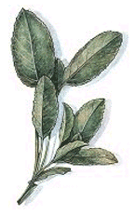
Sage
Introduction
This fact sheet provides basic information about Sage. Sage is a silvery-green plant with leaves that offer a memorable fragrant. The most common variety of sage was first found growing in regions around the Mediterranean but now grows in regions of North America as well. The leaves of the sage herb serve both medicinal and culinary purposes.The name salvia derives from the Latin salvere, meaning to cure. Traditionally, sage and its oil have been used for the treatment of a wide range of illnesses. Ethanolic tinctures and decoctions have been used to treat various inflammations of the oral cavity and gastrointestinal tract; sage has also been used as a tonic and antispasmodic. The plant has been employed topically as an antiseptic and astringent and has been used to manage excessive sweating. Sage has been used internally as a tea for the treatment of dysmenorrhea, diarrhea, gastritis, tonsillitis, and sore throat. The dried leaves have been smoked to treat asthma.
Dried sage leaf is used as a culinary spice and as a source of sage oil, which is obtained by steam distillation. The fragrance of the plant is said to suppress the unpleasant odor of fish. Sage oil is used as a fragrance in soaps and perfumes. It is a widely used food flavoring, and sage oleoresin is also used in the culinary industry.
Common Names
Sage, Garden Sage, True Sage, Scarlet Sage, Meadow SageLatin Names
Salvia officinalisWhat It Is Used For
- Dried sage leaf is used as a culinary spice and as a source of sage oil. Medicinally, the plant has antispasmodic and carminative properties. Sage leaves, apart from their culinary uses, have been recommended for dyspepsia, excessive sweating, and as a gargle in coughs and colds.
How It Is Used
For a variety of conditions including mouth inflammation, gingivitis and sore throats, add 3 grams of sage leaf to 150 ml of boiling water, strain after 10 minutes and then let cool. The resulting tea can then be used as a mouthwash or gargle a few times a day.What the Science Says
- Sage leaves, apart from their culinary uses, have been recommended for dyspepsia, excessive sweating, and as a gargle in coughs and colds.
Side Effects and Cautions
- Reported side effects from the ingestion of sage include cheilitis, stomatitis, dry mouth, or local irritation. Cheilitis and stomatitis have been reported in some cases following the ingestion of sage tea. Ingestion of large amounts of the plant extract may cause dry mouth or local irritation according to some reports.
Sources
- Drugs.Com Web site. Accessed on February 7, 2009.
- From Wikipedia, the free encyclopedia. Accessed on February 7, 2009.






